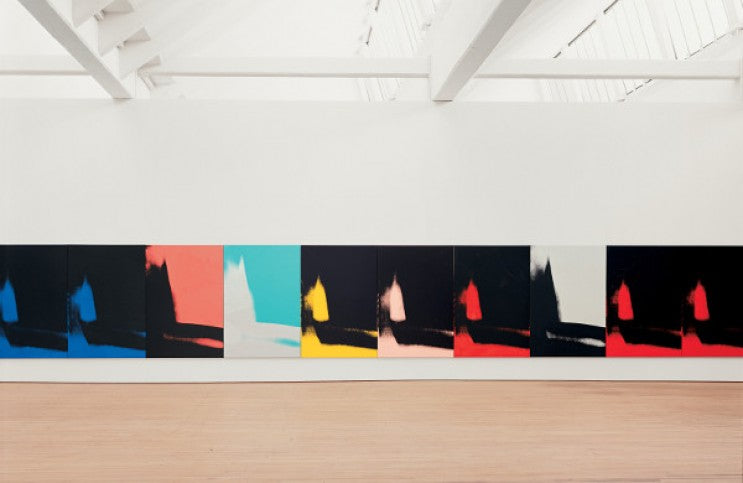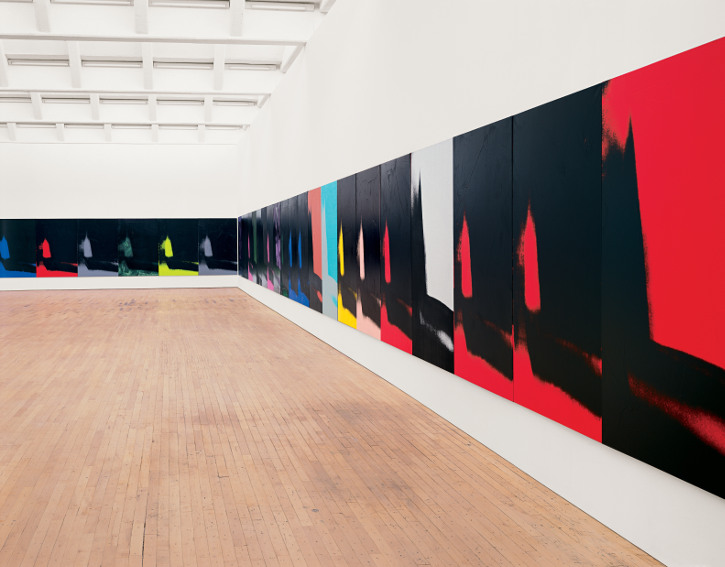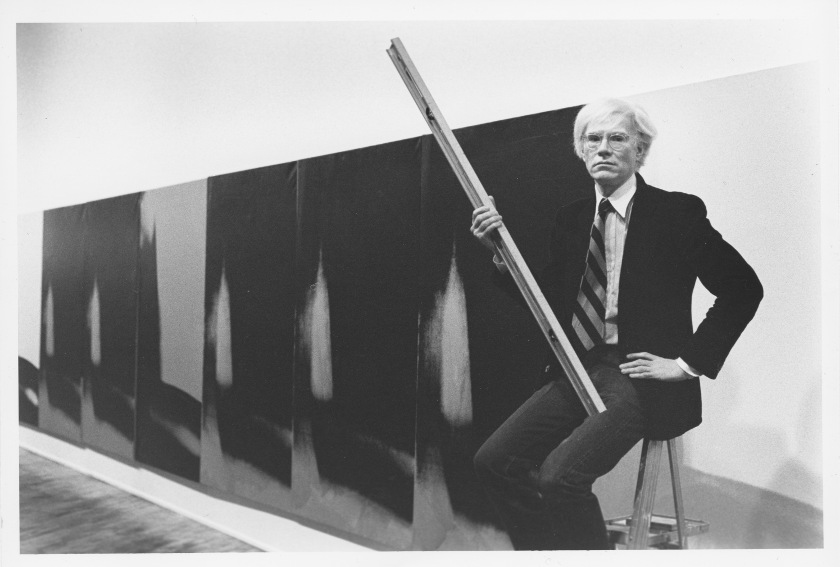
Shedding a Light on Andy Warhol's Shadows
This month, “Shadows” (1978-79) by Andy Warhol will be partially on view at the headquarters of Calvin Klein, at 205 W 39th Street in Midtown Manhattan. The most ambitious work Warhol ever created, “Shadows” consists of 102 canvases that hang end to end to form a single monumental installation. The work normally hangs at Dia:Beacon in upstate New York, but it sometimes travels. The number of canvases exhibited in such instances depends on the amount of available continuous wall space. In the case of CK HQ, the street level gallery has room for 50 canvases, almost half of the total installation. The 52 canvases not on view will be back in Beacon getting refurbished, also courtesy of Calvin Klein. The clothing brand partnered with the Andy Warhol Foundation last year on a two-year deal to release fashion products featuring Warhol images. Tote bags, shoes, accessories, and other ready to wear items decorated with glimpses of silkscreened electric chairs and other iconic Warhol images are currently available. That partnership was also the impetus for the exhibition of the “Shadow” series. A major Warhol retrospective opens in November 2018 at the Whitney Museum of American Art, located two miles away in Lower Manhattan. Curators wanted to exhibit “Shadows” somewhere else in New York in conjunction with the retrospective, and since all of the Dia spaces in town were occupied Calvin Klein offered its space. The pairing is fitting, not only for the beauty of the location, but also for the way it challenges us to look beyond superficiality to discover the most beautiful, most difficult, and most abstract aspects of what we think we see.
The Shadow Does Not Know
Like many Warhol series, “Shadows” repeats a single image—in this case two shadows superimposed over each other. To create the composition, Warhol photographed two sculptural models of angled peaks, one smaller than the other. He combined the two images then screenprinted it on 102 identically-sized canvases, adding hand-painted touches to the canvases. He allowed himself only two hues for each canvas. Since Warhol considered the 102 canvases to be a single artwork, each canvas can be considered a formal element—102 forms in a room-sized work. It is precisely the formal aspects of the work that cause many writers to mistakenly write about its alleged qualities. Some critics have called “Shadows” a meditation on color and form; others have called it a painterly exploration of typology. I, however, think there is something fundamentally incomplete about those assessments. To my mind, everything Warhol made was abstract, and “Shadows” is a key with which to unlock a broader understanding of his entire oeuvre.

Andy Warhol, Shadows, 1978–79. Installation view, Dia:Beacon, Beacon, New York, 2003–11. © The Andy Warhol Foundation for the Visual Arts, Inc./Artists Rights Society (ARS), New York. Photo: Bill Jacobson Studio, New York. Courtesy Dia Art Foundation, New York
Consider the fact that Warhol is amongst the most famous artists who ever lived. Yet to be famous does not mean the same thing as to be understood. When people look at his “Brillo Boxes” (1964), they think Warhol copied a Brillo soap box as a statement about popular media or consumerism. When they look at one of his giant screenprint paintings of Chairman Mao Zedong, they think Warhol was making a statement about celebrity or the cult of personality surrounding demagogues. But there are larger questions being posed by these works. The most important is, “Do you actually know what are you looking at?” In the case of “Shadows” we think we are looking at a bunch of copies of a picture of two shadows, repeated in various color combinations as a formal abstract gesture. But what “Shadows” actually shows us is an invitation to open our minds up to what we do not see.

Andy Warhol with Shadows (1978–79) at Heiner Friedrich Gallery, 393 West Broadway, New York, in 1979. © The Andy Warhol Foundation for the Visual Arts, Inc./Artists Rights Society (ARS), New York. Photo: Arthur Tess. Courtesy Dia Art Foundation, New York
An Allegory on 39th Street
I believe “Shadows” is a manifestation of the Allegory of the Cave, a story invented by the Greek philosopher Plato to explain his Theory of Forms. The Theory of Forms posits that the most accurate version of reality exists in the non-physical realm of ideas. Everything we experience with our senses while moving through physical existence is but a shadow of an idea that exists in that enigmatic realm. To explain this theory, Plato told a story of some people imprisoned in a cave. The people are seated, facing a blank wall. Unbeknownst to them, a fire is burning in the back of the cave. Between the fire and the people, a puppet show is going on. The light from the fire casts shadows of the puppet show onto the wall. The people are watching the shadows on the wall, but they do not know they are watching only superficial, enigmatic representations of reality. They think the shadows have substance.

Andy Warhol, Shadows, 1978–79. Installation view, Dia Center for the Arts, 545 West 22nd Street, New York, 1998–99. © The Andy Warhol Foundation for the Visual Arts, Inc./Artists Rights Society (ARS), New York. Photo: Cathy Carver. Courtesy Dia Art Foundation, New York
When you view the Warhol “Shadows” series, imagine that you are one of those people sitting in the cave watching shadows dance across the wall. Do not be distracted by the superficial aspects of these enigmatic representations. Do not be fooled into thinking you are looking at a meditation on color, nor a painterly exploration of typology. What seems to have substance is an illusion. Forget what you think you know; look beyond what other people are telling you is real; open your mind to the idea that there might be something else going on here that is not obvious at first. What is behind these pictures? What is going on beyond the surface of this artwork, and the Brillo Boxes, and the Mao Zedong paintings, and the Electric Chair series? For that matter what is going on beyond the surface of everything? Is there really any such thing as Pop Art, or abstraction, or Calvin Klein tote bags? Or is it all just an elaborate puppet show distracting us from the beautiful truth of our own ideas? “Andy Warhol: Shadows” is on view from 26 October through 15 December 15 2018. Andy Warhol: From A to B and Back Again is on view at the Whitney from 12 November 2018 through 31 March 2019.
Featured image: Andy Warhol, Shadows, 1978–79. Installation view, Dia:Beacon, Beacon, New York, 2003–11. © The Andy Warhol Foundation for the Visual Arts, Inc./Artists Rights Society (ARS), New York. Photo: Bill Jacobson Studio, New York. Courtesy Dia Art Foundation, New York
By Phillip Barcio






